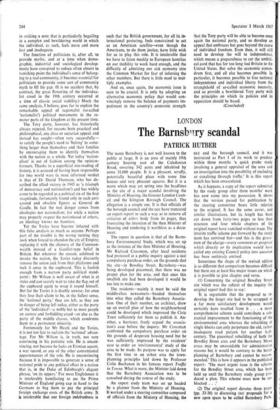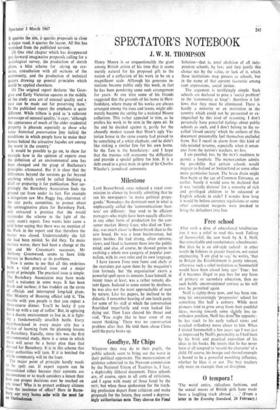The Barnsb'iry scandal
LONDON PATRICK HUTBER
The name Barnsbury is not well known to the public at large. It is an area of mainly 19th century housing east of the Caledonian Road, covering 342 acres and inhabited by some 31,000 people. It is a pleasant, scruffy, potentially beautiful place with some fine houses and very pleasant squares. But it is a name which may yet spring into the headlines as the site of a major scandal involving the Ministry of Housing, the Greater London Coun- cil and the Islington Borough Council. The allegation is a simple one. It is that officials of the borough council and the Gi.c have truncated an expert report in such a way as to remove all criticism of either body from its pages, thus frustrating the intention of the then Minister of Housing and rendering it worthless as a docu- ment.
The report in question is that of the Barns- bury Environmental Study, which was set up at the instance of the then Minister of Housing, Mr Richard Crossman, after local residents had protested at a public inquiry against a OLC compulsory purchase order, on the grounds that the site—in Bewdley Street, Barnsbury—was being developed piecemeal, that there was no proper plan for the area, and that once this smallish site had been developed it would be too late to make one.
The residents—mainly it must be said the middle-class newcomers—banded themselves into what they called the Barnsbury Associa- tion. One of their number, an architect, drew up an overall plan of how the neighbourhood could be developed which impressed the Civic Trust sufficiently for them to publish it. An- other, a barrister, freely argued the associa- tion's case before the inquiry. Mr Crossman confirmed the compulsory purchase order on the grounds of desperate housing need but he was sufficiently impressed by the residents' case to order an 'environmental' study of the area to be made. Its purpose was to apply for the first time to an urban area the town- planning principles laid down by Professor Colin Buchanan in his famous report Traffic in Towns. What is more, the Minister laid down that the Barnsbury Association was to be consulted during the course of the study.
An expert study team was set up headed by a planner from the Ministry of Housing. It worked under a steering committee composed of officials from the Ministry of Housing, the ow and the borough council, and it was instructed as Part 1 of its work to produce within three months 'a quick probe study involving a general appraisal of the area and an investigation into the possibility of excluding or canalising through traffic.' It is this report which has been emasculated.
As it happens, a copy of the report submitted by the study group after three months' work has now come into my possession. It shows that the version passed for publication by the steering committee bears little relation to the original. It has the same cover, and similar illustrations, but its length has been cut down from forty-two pages to less than nineteen and four whole chapters of the original report have vanished without trace. The interim traffic scheme put forward by the study team has survived but—and this is the grava- men of the charge—every comment or proposal which directly or by implication would have called any existing Council policy into question has been ruthlessly excised.
Sometimes the shape of the revised edition is so different that comparison becomes difficult but there are at least five major issues on which it is possible to give chapter and verse.
(1) Concerning the original Bewdley Street site which was the subject of the inquiry the original report had this to say:
'It is regrettable that the proposal to re- develop the larger site had to be scrapped as a far more satisfactory development would certainly have resulted from it . . . a more comprehensive scheme could contribute a sub- stantial improvement to the functioning of the environmental area whereas the rebuilding of single blocks can only perpetuate the old, rather inadequate road pattern for another half- century. The piecemeal rebuilding of both the Bewdley Street area and the Barnsbury Mews areas may be unavoidable for administrative reasons but it would be contrary to the better planning of Barnsbury and cannot be recom- mended.' This is how it appears in the published report: 'The most urgent issue is the scheme for the Bewdley Street area, which has been held up until the Barnsbury study group pro- duced a plan. This scheme must now be un- blocked . .
(2) The original report devotes three pages (pp. 33-36) to discussing GLC proposals for new open space to be called Barnsbury Park.
It queries the site, it queries proposals to close a major road, it queries the layout_ All this has vanished from the published version.
(3) One vital chapter which has disappeared put forward imaginative proposals calling for a sociological survey, the production of sketch plans, a blitz scheme for .idying up eye- sores, consultation with all sections of the community, and the production of technical papers drawing up, general principles which could be applied elsewhere.
(4) The original report declares 'the Geor- gian and Early Victorian squares in the middle of the study area are of unusual quality and a case can be made out for preserving them.' In the published report the emphasis is quite different. While tribute is paid to 'a coherent townscape of unusual quality,' it says: 'although the appearance of much of the older residential property is pleasant especially to those who value historical preservation [my italics] the conditions in which people have to make their homes behind the attractive facades are among the worst in the country.'
It would be possible to go on, to show for example how in the opinion of experts even the definition of an environmental area has been changed and the grasp of Buchanan's principles attenuated. But it is clear that the differences beyond the versions go far beyond anything which could be called finalising a draft or preparing it for publication. Not sur- prisingly the Barnsbury Association finds the ground cut from under its feet. For example a delegation saw Mrs Peggy Jay, chairman of the °Lc parks committee, to protest about the unimaginative plans for Barnsbury Park, and extracted .a promise that she would reconsider the scheme in the light of the study team's report. Two weeks later came a cold letter saying that there was no mention of the Park in the report and that therefore the matter was closed. Understandably she felt she had been misled. So did they. To make mailers worse, there had been a change at the top and Mr Crossman's successor, Mr Anthony Greenwood, seems to have little interest in Barnsbury or its problems.
Now it seems to me that all this enshrines both a vitpi practical issue and a major point of principle. The practical issue is simple. The Barnsbury Association may have made itself a nuisance in some ways. It has been brash and tactless; it has trodden on the corns of officials and interrupted long-laid plans. One Ministry of Housing official told it, 'The trouble with you people is that you expect a three-course dinner. You'll be lucky if you finish up with a cup of coffee.' But, in agitating for a decent environment to live in, it is fight- ing a fundamentally unselfish battle. Every neighbourhood in every major city has a chance of learning from the planning lessons of Barnsbury. Equally, since this was the first environmental study, there is a sense in which there will never be a better plan than that devised for Bamsbury. It is to this scheme that other authorities will turn. If it is botched the whole community will be the loser. The major point of principle hardly needs to be spelt out. If expert reports can be emasculated either because their contents are inconvenient or to teach outsiders a lesson then how can proper decisions ever be reached on any issue? Who is to protect ordinary citizens from the insolence of office? Here in Barns- bury our very bones ache with the need for an Ombudsman.



































 Previous page
Previous page